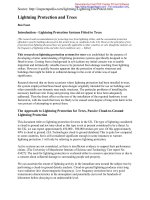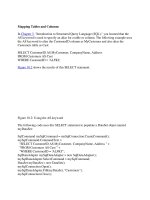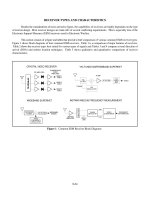Tài liệu “Free-Range” Poultry and Eggs doc
Bạn đang xem bản rút gọn của tài liệu. Xem và tải ngay bản đầy đủ của tài liệu tại đây (923.69 KB, 8 trang )
United Poultry Concerns, Inc.
PO Box 150
Machipongo, Virginia 23405
(757) 678-7875
www.upc-online.org
“The waiter said, ‘All of our chicken is free-range.’ And
I said, ‘He doesn’t look very free there on that plate.’”
– Joe Bob Briggs, “We Are the Weird”
“Free-range” evokes a positive image of chickens and
turkeys living outdoors with plenty of fresh air, sunshine
and open space to roam in.
“Cage-Free” conveys a similar impression of hens living
“free” as nature intended. What are the realities behind
“free range” and “cage-free” labels?
“Free-Range” Poultry and Eggs
Not All They’re Cracked Up To Be
2
Birds raised for meat may be sold as “free-range” if they have government
certified access to the outdoors. The door may be open for only five minutes
and the farm still qualifies as “free-range.” Apart from the “open door,” no
other criteria such as environmental quality, number of birds, or space per
bird, are included in the term “free-range.” A government official said: “Places
I’ve visited may have just a gravel yard with no alfalfa or other vegetation.”
A visitor to Polyface Farm in Virginia
wrote: “I toured Polyface on a sweltering
day. Chickens were in tiny cages with
tin roofs in the beating sun, panting
like mad. The cages were located over
manure piles the birds were supposed
to eat larvae from. Rabbits were kept in
factory-farm conditions in suspended,
barren wire cages. There was no sign
of freedom or compassion for these
animals.”
Visitors to Springfield Farm in Sparks,
Maryland reported: “The ‘free-range’
turkeys we saw were housed in a field in
the freezing cold with no shelter except
a small wooden tarp-covered structure
only big enough for half of them. The
others huddled together shivering in the weather. The farmer roughly grabbed
the turkeys by their legs and held them upside down while they flapped their
wings desperately to upright themselves. That is how he carried them.”
Photo by: East Bay Animal Advocates
“Free-range organic” young turkeys with surgically mutilated beaks
at Diestel Turkey Ranch, a supplier to Whole Foods.
“Free-Range” Birds Raised For Meat
After 3 days without food, birds at Polyface are
stued into metal killing cones and brutally
butchered, as in this picture of a terried “free-
range” rooster being cut to death with a knife.
3
Free-range hens are typically debeaked
as chicks at the hatchery the same as
battery-caged hens. Debeaking is a
painful facial mutilation that impairs a
hen’s ability to eat normally and preen
her feathers. Typically, 2,000 to 20,000
or more hens – each hen having one
square foot of living space the size of a
sheet of paper – are confined in a shed
with little or no access to the outdoors.
If the hens can go outside, the exit is
often very small, allowing only the
closest hens to get out. And the “range”
may be nothing more than a mudyard
saturated with manure.
“Free-Range” Hens Kept for Eggs
Severed beaks in the bottom
of a debeaking machine.
Chick about to be debeaked at the hatchery.
Debeaked chicks with bloody beaks.
“Organic” and “Certif ied Humane” Eggs
“Pete and Gerry’s Organic Eggs” in New Hampshire exemplifies the misleading
muddle of “organic,” “humane,” “free-range,” and “cage-free” advertising.
Despite the “Certified Humane” logo, visitors were shocked to find 100,000
debeaked hens crowded into five 400 ft long sheds, each holding “a sea of
20,000 brown hens,” so densely crowded the floor was invisible. Though it was
a mild September day in a lush green valley, the visitors said they “couldn’t see
any hens enjoying the grass, just several large sheds that took up most of the
farm.” The “range,” even if the hens had been outside, was just “a bare patch of
dirt between the sheds.”
4
“Cage-Free” Hens Kept for Eggs
“Cage-free” means that, while the hens are not squeezed into small wire cages,
they never go outside. “Cage-free” hens are typically confined in dark, crowded
buildings filled with toxic gases and disease microbes the same as their battery-
caged sisters. And like their battery-caged sisters, they are painfully debeaked at
the hatchery. While chickens are designed to dig in the ground for food with
their beaks and claws, when deprived of outlets suited to their energies and
interests, they can be driven to peck at each other, having nothing to do
with their time once they’ve laid their egg for the day in a barren building.
Chickens love sunlight – they sunbathe daily outdoors – but “cage-free” hens
are denied even this simple pleasure.
Black Eagle Farm, a “cage-free” operation in Virginia, houses 48,000 hens.
Platforms are designed to cram as many hens as possible into the building.
This is a typical large-scale commercial operation being advertised as “animal friendly.”
5
“Free-Range,” “Cage-Free” and “Organic”
Hens are Slaughtered the Same as Birds
Raised for Meat
Though chickens can live active lives for 7 to 15 years, “free-range,” “cage-
free,” and “organic” hens are grabbed upside down by their legs, thrown into
transport trucks
like garbage, and
hauled to slaughter
the same as battery-
caged hens at
extremely young
ages. Many of these
gentle hens are
sold to live poultry
markets where they
sit for days in filthy
cages listening to
the screams of their
cagemates being
butchered in the
back room.
Young female chickens await suering and death in a U.S. “meat” slaughterhouse.
Many hens from cage-free and battery-cage egg operations end up
in hellholes like Nick’s live poultry market in New York City.
Photos by: Adam Parascandola and Carol McCormick
Photo by: Sarah Anikin
To see how these birds are treated, go to www.upc-online.org/livemarkets
and watch the video Inside a Live Poultry Market.
6
“Egg-Type” Male Chicks are Trashed at Birth
Newborn male chickens are thrown into plastic trash bags at the hatchery.
This is a standard egg production farming practice throughout the world.
Egg production produces “excess” male chicks with no commercial value since
male birds don’t lay eggs. Therefore, the baby brothers of all hens used for
all egg production – regardless of the label – are suffocated to death in trash
cans, electrocuted, gassed, or ground up alive as soon as they break out of their
shells. For every “free-range,” “cage-free,” or “organic” hen, a baby rooster is
born and trashed. No federal laws protect chickens from abuse under any label.
7
“Free-Range” Poultry and Eggs: Dierent
from Factory Farming?
It is a myth that “free range” poultry and egg production is separate
from industrial animal production. All forms of animal production are
economically related. For example, many small farms buy their birds from
mega-industrial factory-farm hatcheries such as Murray McMurray in Iowa.
McMurray alone ships 100,000 chicks each week to buyers. “Free-range”
producers have joined together with the U.S. Postal Service, cockfighters and
other vested interests to force the airlines to ship baby chicks like luggage,
because it is cheapest.
Millions of chicks die enroute of starvation, dehydration and terror. Despite
the factory-farm connection and total inhumaneness, Polyface owner Joel
Salatin speaks for the “free-range” lobby: “We small independent producers
rely on that transport. It’s our very lifeblood.” He also says: “People have a
soul; animals don’t. Unlike us, animals are not created in God’s image.”
All Hatchery Photos: Courtesy of The Animals Voice
8
What Can I Do?
Please show kindness and respect to birds and other animals by not eating
them or their eggs or drinking their milk. Instead, discover the variety of
all-vegetarian, vegan foods and cooking ideas. For recipes and cookbooks,
go to www.upc-online.org/recipes/. For vegetarian and healthy food options
worldwide, go to HappyCow Compassionate Eating Guide at
www.HappyCow.net.
United Poultry Concerns is a nonprofit organization dedicated to the compassionate
and respectful treatment of chickens, turkeys, ducks and other domestic fowl. We seek
to make the public aware of how these birds are treated, and to promote the benefits of a
vegan diet and lifestyle. We invite you to join us and support our work. For information
about all forms of poultry and egg production, see Prisoned Chickens, Poisoned Eggs: An
Inside Look at the Modern Poultry Industry by Karen Davis, PhD. Order at www.upc-
online.org or send $14.95 check or money order to the address below. Thank you!
United Poultry Concerns is a nonprofit 501(c)(3) organization. Federal ID: 52-1705678
For references, visit www.upc-online.org/freerange.html
United Poultry Concerns, Inc.
PO Box 150
Machipongo, Virginia 23405
(757) 678-7875
www.upc-online.org
Egg-Free Baking Tips
l• Vinegar and Baking Soda: For a rising or lightening effect in cakes,
cupcakes and breads, combine 1 teaspoon of baking soda with 1 tablespoon of
vinegar.
l• Ground Flaxseed: Rich in essential omega-3 fatty acids, 1 tablespoon of
ground flaxseed whisked with 3 tablespoons of water in a blender or food proces-
sor will replace one egg. Flaxseed works best in nutty, grainy items like pancakes,
waffles, bran muffins and oatmeal cookies.
l• Bananas: For its binding abilities, half of a potassium and magnesium rich
mashed or pureed banana will generally replace one or two eggs in breads, muf-
fins, cakes and pancakes.
l• Applesauce: Full of fiber and vitamin C, unsweetened applesauce offers the
binding and moisture needed in baked goods. 1/4 cup equals one egg. Apple-
sauce works best when you want the results to be moist, as in brownies.
l• Silken Tofu: Rich in protein and fiber, but without the cholesterol and
little, if any, saturated fat, this soy-based ingredient works best in dense, moist
cakes and brownies. One egg can be replaced with 1/4 cup of tofu whipped in a
blender or food processor.
l• ENER-G Egg Replacer: Available in a handy box in most food stores, this
nonperishable powdered product works well in baking, but is best in cookies.
Adapted by Rhode Island Vegan Awareness from The Joy of Vegan Baking: The Compassionate Cooks’
Traditional Treats and Sinful Sweets, by Colleen Patrick-Goudreau, 2007.









